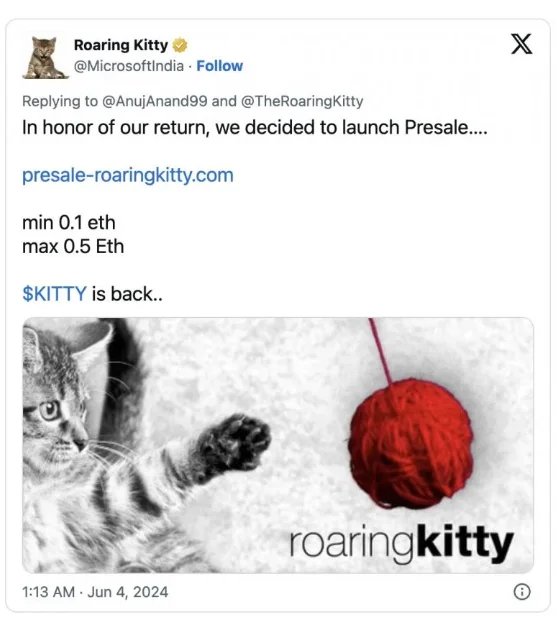Verified Microsoft India X Account Hacked

The hackers continue to repost their stuff from their account on the Microsoft India X account, which has not yet been restored.
Samiksha Jain June 4th, 2024

Share on LinkedInShare on Twitter
The official Microsoft India X, formerly known as a Twitter account, has been hacked by cryptocurrency scammers. With over 211.3k followers, the golden tick verified account, Microsoft India X account became the prime target of scammers as it offers the hijackers a legitimate platform for their fraudulent activities.
The Microsoft India X account is hacked under the name of Roaring Kitty. On accessing its account the description was “A method for hunting stocks and pouncing on investment opportunities. Live streams on Mon/Wed/Fri from 7-10 pm ET. For educational purposes only.”
Microsoft India X Account Hacked
They used the hacked Microsoft India X account to reply to tweets, directing users to a fake website, presaIe-roaringkitty[.]com. This site falsely claimed to offer a chance to buy GameStop (GME) crypto in a presale. Still, in reality, it was set up to steal assets from anyone who connected their cryptocurrency wallets and approved transactions.

Source: X

Microsoft India X Account Hacked
Although these posts have been removed, the hackers continue to repost their stuff from their account on the Microsoft India X account, which has not yet been restored.
The Cyber Express Team has reached out to Microsoft India for more information, but as of writing this news report, there has been no response.
Hijacking Verified X Account: A Trend
Hijacking of Microsoft India X account is not a new incident, in fact it is part of a worrying trend where verified X accounts are targeted by scammers. Previously, the U.S. Securities and Exchange Commission (SEC) confirmed that its verified X account was hacked due to a SIM-swapping attack on the phone number linked to the account.
Similarly, the official X accounts of tech giant Netgear and Hyundai MEA (Middle East & Africa) were also hacked, spreading malware to steal from cryptocurrency wallets. These accounts had over 160,000 followers combined.
Other high-profile breaches include accounts of well-known entities and individuals like the cybersecurity firm Mandiant, Ethereum co-founder Vitalik Buterin, and Donald Trump Jr. Most of these hacks are linked to Bitcoin scams, highlighting a troubling pattern in the digital world. These compromised accounts endanger their followers and pose a significant security risk to X’s 528 million users.
The big question is why are trusted X accounts being used for Bitcoin scams, and what does this mean for online security and digital currency?
There may be a few reasons for this trend. First, accounts with many followers and verified status seem more credible, making it easier for scammers to trick people. Second, the sophisticated nature of these attacks, like SIM-swapping and social engineering, shows weaknesses in current security measures. Lastly, the growing popularity of cryptocurrency makes it an attractive target for cybercriminals.
Therefore, social media platforms like X must improve security, including stronger authentication methods to prevent unauthorized access. This might involve multi-factor authentication and educating users about phishing and other cyber threats.
For the cryptocurrency market, these incidents highlight the need for better security and regulations. As digital currencies become more common, ensuring safe transactions and protecting users from scams is crucial. This might involve developing more secure wallet solutions and making transactions more transparent.
The hacking of the Microsoft India X account is a clear reminder of the growing threat of cybercrime. It shows the need for constant vigilance and adaptation to new scams. Users, companies, and regulators must work together to protect the digital world and ensure that trust and security are prioritized.
As we wait for more updates on the Microsoft India account, everyone in the cybersecurity community and beyond should stay alert, learn from these incidents, and strengthen their defenses against future cyberattacks. The fight against cybercrime is ongoing, and only by working together can we make the digital space safer for everyone.





